In the avian world, a fascinating phenomenon unfolds when small birds fearlessly take on their formidable predators, hawks. From a distance, it seems very brave of the small birds to attack such a capable opponent.
These seemingly audacious encounters have puzzled bird enthusiasts and researchers alike, prompting the question: why do small birds attack hawks? How do they attack?
This intriguing behavior is not only a display of bravery but also serves a crucial purpose for the smaller birds’ survival.
By joining forces and employing clever tactics, these feathered underdogs can successfully fend off their aerial adversaries. In this article, we will delve into the motivations behind these attacks.
We’ll also explore the various strategies employed by small birds to combat hawks, shedding light on the remarkable resilience and resourcefulness of these pint-sized warriors.
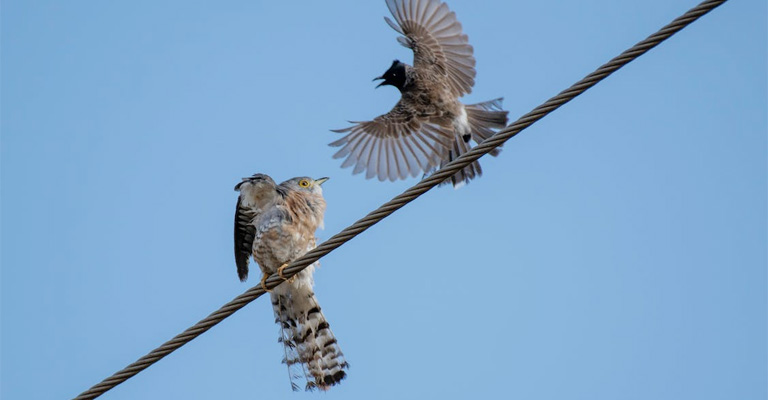
Why Do Small Birds Attack Hawks? How Do They Attack
The reasons behind small birds attacking hawks are multifaceted. Firstly, small birds engage in these attacks as a means of defense.
They fiercely guard their nesting sites and feeding areas, and when a hawk encroaches upon their territory, they launch a coordinated assault.
By mobbing the hawk, they aim to drive it away and protect their valuable resources. Here are the details:
Why Do Small Birds Attack Hawks?
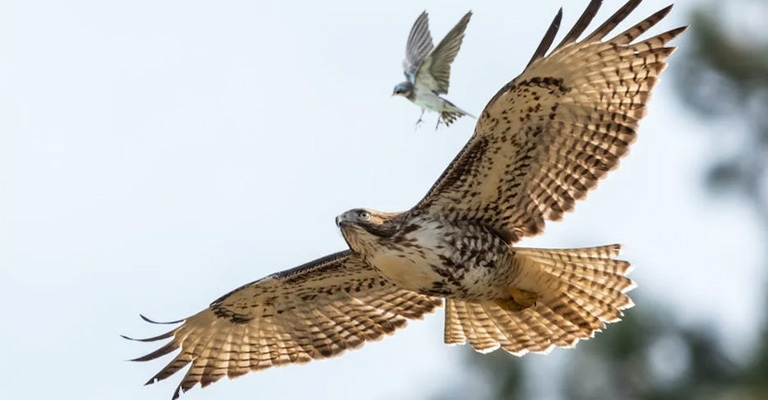
Small birds often attack hawks for several reasons:
Defense of Territory
Small birds are territorial and will defend their nesting sites and feeding areas from potential threats, including hawks. By attacking the hawk, they aim to drive it away and protect their resources.
Protection of Young
Hawks are known predators, and small birds will aggressively defend their nests and offspring from any potential danger. By mobbing the hawk, they try to distract and intimidate it, reducing the risk to their young.
Safety in Numbers
Small birds often engage in mobbing behavior, where multiple individuals join forces to harass and intimidate predators. By mobbing a hawk, they increase their chances of successfully driving it away, as the combined effort can overwhelm the larger bird.
Warning Other Birds
When small birds spot a hawk, they may engage in mobbing behavior to alert other birds in the vicinity of the predator’s presence. This warning allows other birds to take evasive action and avoid becoming prey themselves.
Confusion and Harassment
Small birds may attack hawks to create confusion and disrupt their hunting behavior. By swooping and diving at the hawk, they make it harder for the predator to focus on its prey, potentially forcing it to abandon the hunt.
Defense of Food Sources
Small birds fiercely protect their food sources, such as fruit trees, berry bushes, or feeding stations. If a hawk is perceived as a threat to their food supply, small birds may attack to safeguard their valuable resources.
Distraction and Diversion
By mobbing and attacking a hawk, small birds can divert its attention away from vulnerable individuals or potential targets. This strategy can give other birds or prey species an opportunity to escape or hide.
Intimidation and Harassment
Small birds may attack hawks as a means of intimidation. By repeatedly swooping and pecking at the larger bird, they aim to intimidate and discourage it from hunting in their vicinity.
Learning and Experience
Young birds often learn from their parents and other members of their species. Mobbing hawks can be a learned behavior passed down through generations, as young birds observe and imitate the defensive actions of their elders.
Aggression and Territorial Disputes
Small birds can be naturally aggressive and territorial, not only towards hawks but also towards other birds of their own species. Mobbing behavior may occur when territorial boundaries overlap, and conflicts arise between individuals or groups.
How Do They Attack?
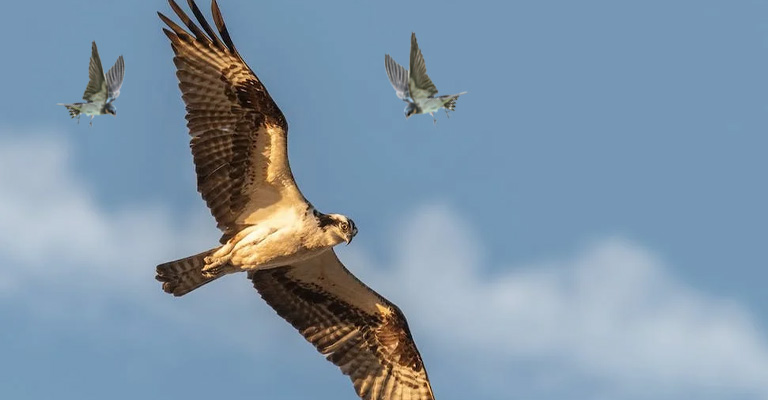
When small birds attack hawks, they employ various tactics to intimidate and drive away the larger predator. Here are some common methods they use:
Dive-bombing
Small birds will swoop down from above and dive toward the hawk, aiming to strike it with their beaks or talons. They may repeat this behavior multiple times, trying to make contact with the hawk’s body or head.
Pecking and Striking
Small birds may repeatedly peck at the hawk’s head, eyes, or back, using their sharp beaks as weapons. They may also strike the hawk with their wings or claws, attempting to inflict pain or discomfort.
Vocalization
Small birds often vocalize loudly while attacking hawks. Their calls serve multiple purposes, including alerting other birds to the presence of the predator and potentially intimidating the hawk with a chorus of alarm calls.
Mobbing in Groups
Small birds frequently engage in mobbing behavior, where multiple individuals join forces to harass and overwhelm the hawk. They may take turns attacking, diving, and swooping at the hawk, creating a chaotic and intimidating environment.
Distraction Displays
Some small birds may perform distraction displays to divert the hawk’s attention. They may feign injury or vulnerability, pretending to have a broken wing or hopping on the ground to lure the hawk away from their nests or young.
Swooping and Hovering
Small birds may swoop down from above and hover in close proximity to the hawk, making rapid and erratic movements. This behavior can startle and disorient the hawk, making it more vulnerable to attack or causing it to abandon its hunting attempt.
Defecation
Some small birds, such as crows, have been observed defecating on hawks during attacks. This behavior not only serves as a physical annoyance but can also carry a strong odor, potentially distracting or repelling the hawk.
Wing-flapping and Wing-slapping
Small birds may aggressively flap their wings and slap them against the hawk’s body or wings. This action can create noise, vibrations, and visual disturbances, further unsettling the hawk and making it uncomfortable.
Harassing from a Distance
In some cases, small birds may choose to harass hawks from a safe distance rather than engage in direct physical contact.
They may fly around the hawk, vocalize loudly, or perform aerial displays to keep the predator on edge and discourage it from approaching.
While small birds can be persistent and aggressive in their attacks, they are generally not capable of inflicting significant harm on hawks. The goal is to harass and intimidate the predator, rather than engage in direct physical confrontation.
Can Hawks Get Injured When Attacked by Small Birds?
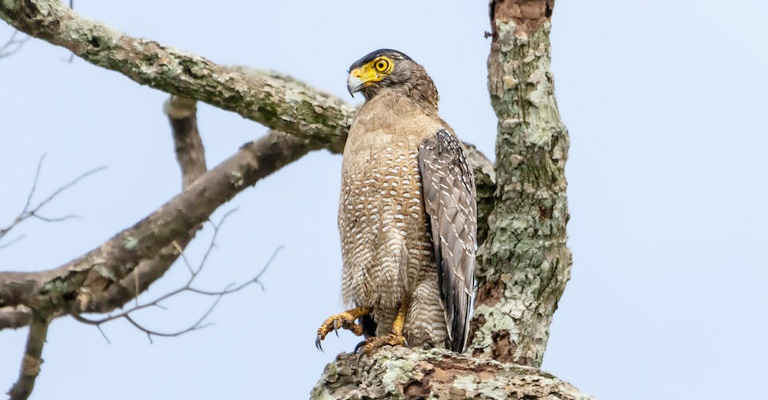
While small birds are not typically capable of inflicting significant harm on hawks, there is a possibility that hawks can sustain injuries during attacks.
However, it is important to note that such injuries are relatively rare and usually minor. Here are a few potential types of injuries that hawks may experience when attacked by small birds:
Scratches and Cuts
Small birds may scratch or peck at the hawk’s skin, potentially causing superficial scratches or cuts. These injuries are typically not severe and tend to heal quickly.
Eye Injuries
Small birds may target the hawk’s eyes during an attack, aiming to impair its vision. While it is uncommon for small birds to cause serious damage to a hawk’s eyes, there is a slight risk of minor injuries such as scratches or irritation.
Feather Damage
Hawks rely on their feathers for flight and insulation. During an attack, small birds may pull or pluck out some of the hawk’s feathers, which can affect its ability to fly efficiently or maintain proper insulation.
Stress-Related Injuries
The stress of being mobbed and repeatedly attacked by small birds can potentially have negative effects on a hawk’s health.
Prolonged stress may lead to physiological changes, such as increased heart rate or elevated stress hormone levels, which can impact the hawk’s overall well-being.
How Do Hawks Defend Against Small Bird Attacks?
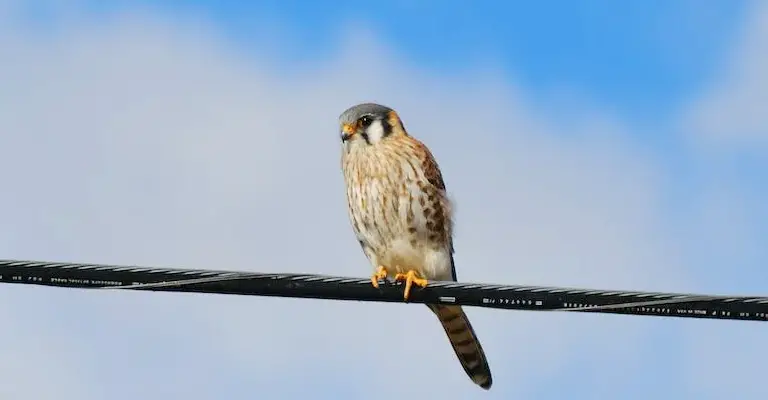
Hawks have several defense mechanisms to protect themselves against small bird attacks. Here are some ways in which Hawks defend themselves:
Flight
Hawks are powerful and agile fliers. When faced with a mob of attacking small birds, hawks often take to the air and try to outmaneuver their assailants. Their superior flight capabilities allow them to evade the small birds and seek safety in the sky.
Intimidation
Hawks are larger and more formidable than small birds, and they can use their size and presence to intimidate their attackers. They may spread their wings, puff up their feathers, and adopt a defensive posture to deter the small birds from getting too close.
Vocalization
Hawks have distinctive calls that they can use to communicate and assert their dominance. When faced with small bird attacks, hawks may vocalize loudly, emitting screeches or screams that can intimidate and discourage their assailants.
Talon Defense
Hawks possess sharp, curved talons that they use for capturing and killing prey. When attacked by small birds, hawks may extend their talons and make slashing motions in the air, warning the small birds to keep their distance.
The threat of being caught by the hawk’s talons is usually enough to dissuade the small birds from continuing their attack.
Retreat
In some cases, hawks may choose to retreat and fly away from the area where they are being mobbed by small birds. Hawks are intelligent birds and recognize when the odds are not in their favor.
They may decide that it is best to avoid confrontation and find a safer location away from the persistent attackers.
FAQs
No, small birds are generally not capable of killing hawks during attacks. Their attacks are more focused on intimidation and harassment rather than inflicting serious harm.
Yes, some species of hawks, such as the Cooper’s hawk and the Sharp-shinned hawk, are known to prey on small birds. However, this does not necessarily mean that all hawks view small birds as prey.
Yes, small birds can be successful in driving away hawks through their mobbing behavior. By working together and persistently attacking, they can create enough disturbance and intimidation to make the hawk retreat.
No, not all small birds attack hawks. The tendency to attack hawks can vary among different species of small birds, and some may be more prone to mobbing behavior than others.
Small bird attacks on hawks are relatively common, especially during the breeding season when small birds are more protective of their nests and young. However, the frequency of such attacks can vary depending on the specific habitat and bird populations in a given area.
Parting Words
The phenomenon of small birds attacking hawks is a testament to the indomitable spirit and ingenuity of nature’s underdogs. These brave avian warriors refuse to be intimidated by their larger predators and instead band together to defend their territories and protect their young.
Through coordinated attacks, dive-bombing maneuvers, and relentless harassment, small birds demonstrate their resourcefulness and adaptability in the face of adversity.
Understanding the motivations behind these attacks not only provides us with a glimpse into the intricate dynamics of the avian world but also highlights the importance of unity and collective action in the pursuit of survival.
So, the next time you witness a small bird fearlessly challenging a hawk, remember the remarkable resilience and determination that lies within these seemingly delicate creatures.